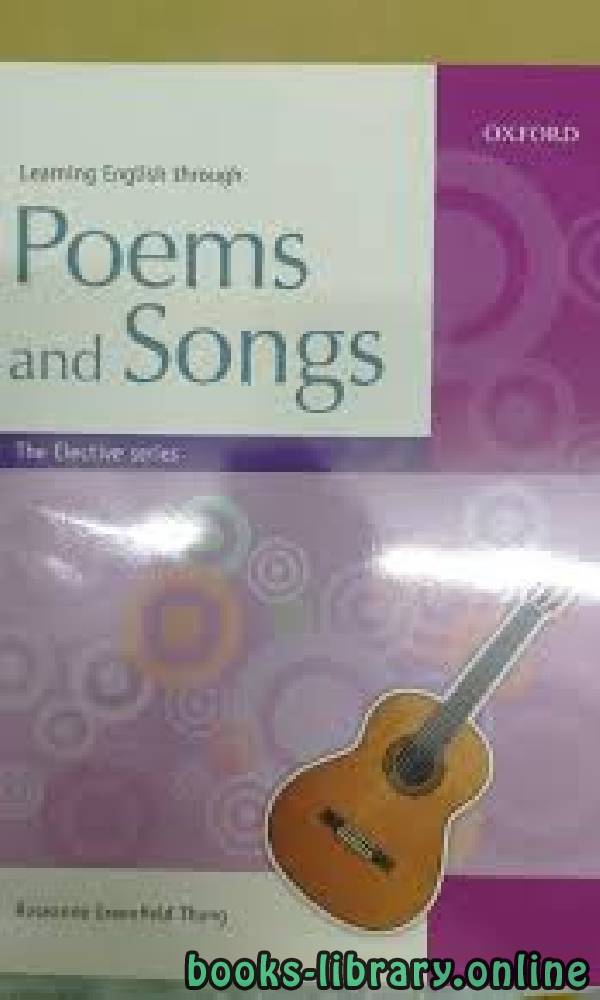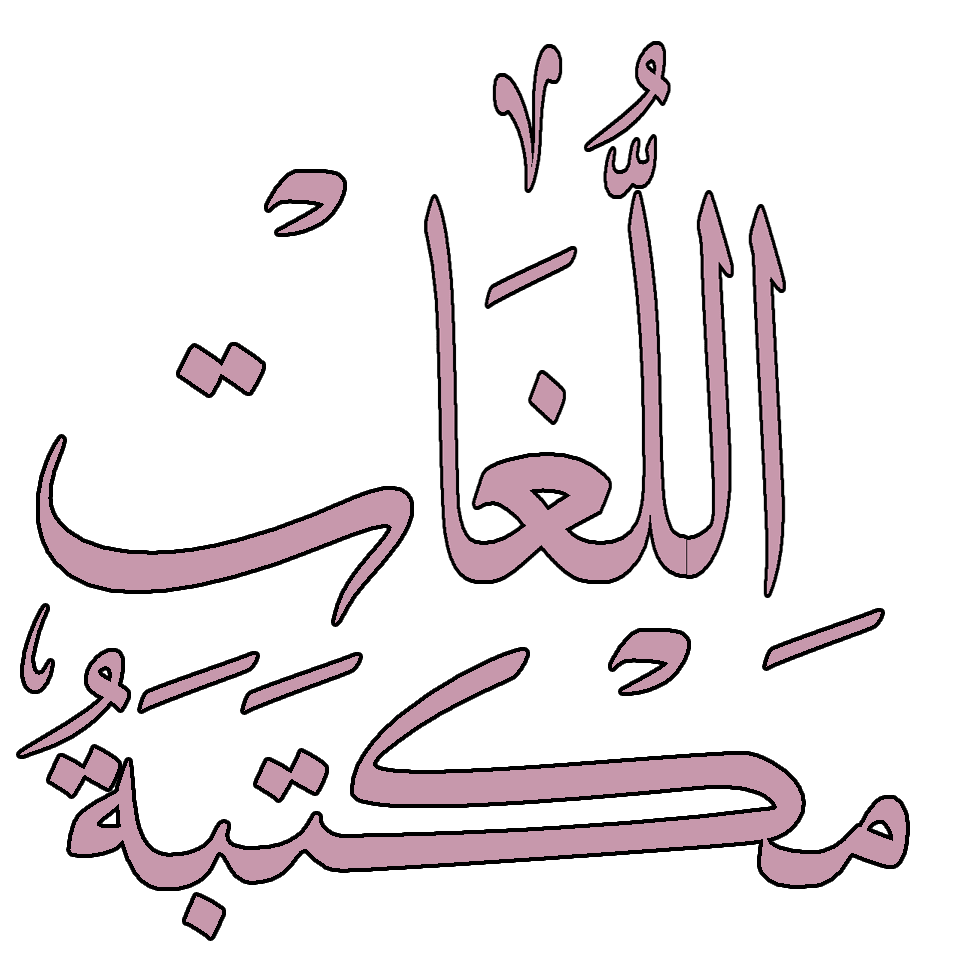📘 قراءة كتاب Learning English through Poems and Songs أونلاين


هذا القسم يحتوي علي العديدمن المصادر التي تختص بالشعر وعلومه.
يصعب تعريف الشعر بطريقة تشمل أنواعه في مختلف اللغات، لكن هناك عدد من التعريفات التي قد تعطي معنى متكاملاً عن ماهية الشعر. عُرّف الشعر بأنه كلام موزون مقفىّ (للشعر العربي)، دالٌ على معنى، ويكون أكثر من بيت، ويشمل هذا التعريف النظم. وقال بعضهم: هو الكلام الذي قصد إلى وزنه وتقفيته قصداً أولياً، فأما ما جاء عفو الخاطر من كلام لم يقصد به الشعر فلا يقال له شعر، وإن كان موزونا. وقد عرفه ابن خلدون بأنه: «هو الكلام البليغ المبني على الاستعارة والأوصاف، المفصل بأجزاء متفقة في الوزن والروي، مستقل كل جزء منها في غرضه ومقصده عما قبله وبعده، الجاري على أساليب العرب المخصوصة به». الشعر: هو شكل من أشكال الفن الأدبي في اللغة التي تستخدم الجمالية والصفات بالإضافة إلى أو بدلاً من معنى الموضوع الواضح. قد تكون كتابة الشعر بشكل مستقل، وقصائد متميزة، أو قد تحدث جنبا إلى جنب مع الفنون الأخرى، كما في الدراما الشعرية، التراتيل، النصوص الشعرية، أو شعر النثر. أما من الناحية المعنوية فإن الشعر هو العِلم.
Poetry (derived from the Greek poiesis, "making") is a form of literature that uses aesthetic and rhythmic qualities of language—such as phonaesthetics, sound symbolism, and metre—to evoke meanings in addition to, or in place of, the prosaic ostensible meaning.
Poetry has a long history dating back to prehistoric times with hunting poetry in Africa, and to panegyric and elegiac court poetry of the empires of the Nile, Niger, and Volta River valleys.[4] Some of the earliest written poetry in Africa is found among the Pyramid Texts written during the 25th century BCE. The earliest Western Asian epic poetry, the Epic of Gilgamesh, was written in Sumerian.
Early poems in the Eurasian continent evolved from folk songs such as the Chinese Shijing; or from a need to retell oral epics, as with the Sanskrit Vedas, the Zoroastrian Gathas, and the Homeric epics, the Iliad and the Odyssey. Ancient Greek attempts to define poetry, such as Aristotle's Poetics, focused on the uses of speech in rhetoric, drama, song, and comedy. Later attempts concentrated on features such as repetition, verse form, and rhyme, and emphasized the aesthetics which distinguish poetry from more objectively-informative prosaic writing.
Poetry uses forms and conventions to suggest differential interpretation to words, or to evoke emotive responses. Devices such as assonance, alliteration, onomatopoeia, and rhythm are sometimes used to achieve musical or incantatory effects. The use of ambiguity, symbolism, irony, and other stylistic elements of poetic diction often leaves a poem open to multiple interpretations. Similarly, figures of speech such as metaphor, simile, and metonymy[5] create a resonance between otherwise disparate images—a layering of meanings, forming connections previously not perceived. Kindred forms of resonance may exist, between individual verses, in their patterns of rhyme or rhythm.
Some poetry types are specific to particular cultures and genres and respond to characteristics of the language in which the poet writes. Readers accustomed to identifying poetry with Dante, Goethe, Mickiewicz, or Rumi may think of it as written in lines based on rhyme and regular meter. There are, however, traditions, such as Biblical poetry, that use other means to create rhythm and euphony. Much modern poetry reflects a critique of poetic tradition,[6] testing the principle of euphony itself or altogether forgoing rhyme or set rhythm.[7][8] In today's increasingly globalized world, poets often adapt forms, styles, and techniques from diverse cultures and languages.
Contents
1 History
1.1 Western traditions
1.2 20th-century and 21st-century disputes
2 Elements
2.1 Prosody
2.1.1 Rhythm
2.1.2 Meter
2.1.3 Metrical patterns
2.2 Rhyme, alliteration, assonance
2.2.1 Rhyming schemes
2.3 Form in poetry
2.3.1 Lines and stanzas
2.3.2 Visual presentation
2.4 Diction
3 Forms
3.1 Sonnet
3.2 Shi
3.3 Villanelle
3.4 Limerick
3.5 Tanka
3.6 Haiku
3.7 Khlong
3.7.1 Khlong si suphap
3.8 Ode
3.9 Ghazal
4 Genres
4.1 Narrative poetry
4.2 Lyric poetry
4.3 Epic poetry
4.4 Satirical poetry
4.5 Elegy
4.6 Verse fable
4.7 Dramatic poetry
4.8 Speculative poetry
4.9 Prose poetry
4.10 Light poetry
4.11 Slam poetry
Learning English through
Poems and Songs
The purpose of this journal activity is to encourage you to access poems and songs as an
independent language learning activity. In parallel to what you will be doing in class for the module,
collect five pieces of work (including both poems and songs) that you like and give your personal
response to them.
Include the following in the Journal for each of the five poems or songs:
• The poem or the song lyrics
• A description of the theme of the poem or song
• Language that you have learned from it
(e.g. vocabulary, metaphors, similes, expressions)
• Your personal response to the poem or song
(e.g. Did you like it? Why or why not? What did the poem or song mean to you?)
The Journal will be used to assess your participation in the module and the progress you make during
it. It should also be something of value to yourself as a reflection of your taste, and something you
can share with others.
english poetry pdf
poetry books pdf
types of poetry
definitions of poetry
types of poetry
poetry english
short poetry
poetry about life
poetry elements
poetry wikipedia
poetry معنى
سنة النشر : 2010م / 1431هـ .
حجم الكتاب عند التحميل : 2.9MB .
نوع الكتاب : pdf.
عداد القراءة:
اذا اعجبك الكتاب فضلاً اضغط على أعجبني و يمكنك تحميله من هنا:

شكرًا لمساهمتكم
شكراً لمساهمتكم معنا في الإرتقاء بمستوى المكتبة ، يمكنكم االتبليغ عن اخطاء او سوء اختيار للكتب وتصنيفها ومحتواها ، أو كتاب يُمنع نشره ، او محمي بحقوق طبع ونشر ، فضلاً قم بالتبليغ عن الكتاب المُخالف:
 قبل تحميل الكتاب ..
قبل تحميل الكتاب ..
يجب ان يتوفر لديكم برنامج تشغيل وقراءة ملفات pdf
يمكن تحميلة من هنا 'http://get.adobe.com/reader/'
The Hong Kong Special Administrative Region
 ❰ ناشرين لمجموعة من المؤلفات أبرزها ❞ Learning English through Poems and Songs ❝ ❞ Hong Kong, China and 1997: Essays in Legal Theory ❝ ❞ The New Legal Order in Hong Kong ❝ ومن أبرز المؤلفين : ❞ English Language Education Section ❝ ❞ ريموند واكس ❝ ❱.المزيد.. كتب The Hong Kong Special Administrative Region
❰ ناشرين لمجموعة من المؤلفات أبرزها ❞ Learning English through Poems and Songs ❝ ❞ Hong Kong, China and 1997: Essays in Legal Theory ❝ ❞ The New Legal Order in Hong Kong ❝ ومن أبرز المؤلفين : ❞ English Language Education Section ❝ ❞ ريموند واكس ❝ ❱.المزيد.. كتب The Hong Kong Special Administrative Region 

 منصّة المكتبة
منصّة المكتبة 